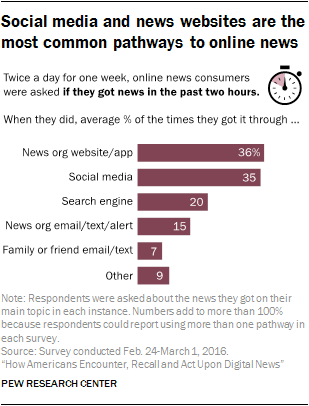How Americans Encounter, Recall and Act Upon Digital News [REPORT]
February 24, 2017
![]() By Amy Mitchell, Jeffrey Gottfried, Elisa Shearer and Kristine Lu
By Amy Mitchell, Jeffrey Gottfried, Elisa Shearer and Kristine Lu
 Anyone who wants to understand today’s news environment faces a challenge: How to discern the nuances of digital news habits when Americans’ attention spans are fractured, human memory is naturally limited and news comes at them every which way.
Anyone who wants to understand today’s news environment faces a challenge: How to discern the nuances of digital news habits when Americans’ attention spans are fractured, human memory is naturally limited and news comes at them every which way.
To tackle this complex question, Pew Research Center, in association with the John S. and James L. Knight Foundation, took on the unusual task of staying in touch with more than 2,000 U.S. adults who get at least some news online over the course of a week. The study ran from Feb. 24 to March 1, 2016. Respondents were asked twice a day whether they got news online within the past two hours and, if so, were asked about their experience with that news. This technique was used to improve the chances that respondents would be able to accurately recall their recent news interactions and allowed researchers to ask about sources and behaviors with a high level of detail. This amounted to up to 14 completed surveys per person for a total of 25,602 interviews – 13,086 of which included online news consumption.
While there are a number of pathways Americans use to get news online, two in this study stand out as the most common: social media and direct visits to news organizations’ websites. When asked how they arrived at news content in their most recent web interaction, online news consumers were about equally likely to get news by going directly to a news website (36% of the times they got news, on average) as getting it through social media (35%). They were less likely to access news through emails, text messages or search engines. And most people favored one pathway over another. Nearly two-thirds (65%) of online news consumers had one preferred pathway for getting most of their online news.
To download report CLICK HERE.






























